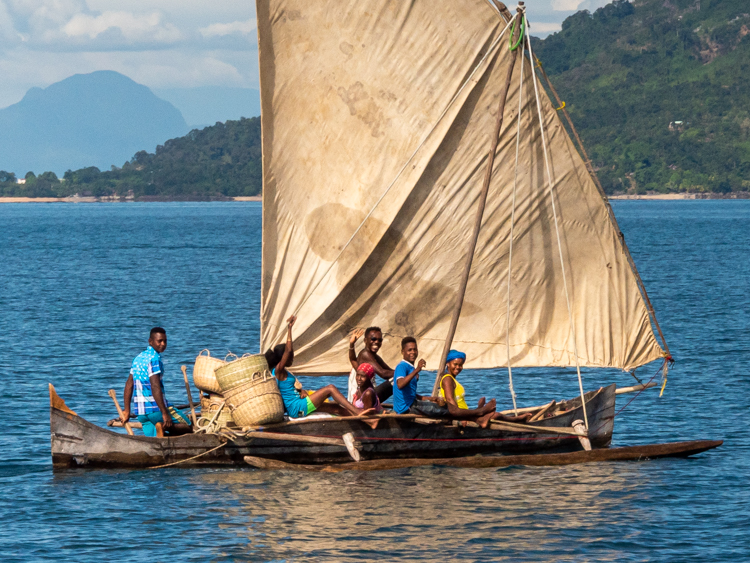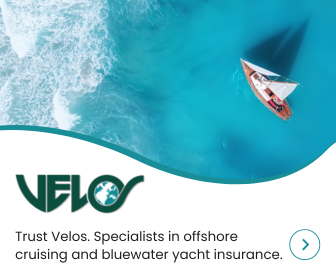Madagascar: A Tale of Officialdom from a Friendly Island Nation
Entering a foreign country usually follows the same process – Customs, Immigration and Health. However, when arriving into a new country by sea, the Port Captain and your vessel are added to the process – which in some countries can mean a lengthy exercise in dealing with officialdom. These cruisers certainly found this was the case in Madagascar, which they visited on their way to South Africa.
Published 1 year ago
Noonsite Note: The cruiser who provided this information wished to remain anonymous. This report from Madagascar reflects their experience – “the next cruiser may find something totally different”, said the author. “This report takes a broader look at officialdom in the world of voyaging yachts and in the context of our own experience.”
Entering a Foreign Jurisdiction by Sea
Entry into foreign jurisdictions, in broad strokes, is the same regardless of mode of travel. Airports make it easy for travellers by co-locating health, customs and immigration right at the airport. No need to consult the port captain. Visitors either need a visa before arrival (available at an embassy or online through an official country website or through one of several contract visa suppliers) or are issued a visa on arrival (VOA). VOAs may be free, or may cost whatever the host country wishes to charge. Some countries charge “tit-for-tat” fees. That is, they treat visitors the same as the visitor’s country treats their citizens.
The process for entry by private yacht is parallel, with the addition of acceptance by the Port Authority. However, officials are rarely co-located at the port of entry, requiring substantial commuting to visit all the officials, in the correct order. Airports are concerned with arriving and departing passengers and their travel documents. Maritime ports are concerned with both passengers AND the yacht itself, which may contain contraband, stowaways, health risks (germs, pests, etc.) and which represents a sizeable sum of money – and tax revenue, should the yacht remain in the host country longer than allowed (importation).


Some countries have arduous rules and processes for managing yachts and crews. Some countries require only inward and outward clearance – always from a well-identified port of entry. Mexico, Argentina, Tanzania, Madagascar and others, require yachts to clear into their country and additionally to clear out and back in with each port captain at subsequent ports of call. The initial entry normally takes a day or so to complete, while the port-to-port clearances normally take an hour clearing out and another hour clearing in – after you find the relevant offices. More yacht-friendly countries facilitate the clearance process by co-locating the official offices and posting the required fees and the required order for clearing with each official (Thailand and Antigua). The French side of St. Martin in the Caribbean simply has a computer terminal in a handy marine chandlery, where visitors enter all their passenger and yacht details and press “print” for a paper confirmation that inward – or outward – clearance is complete.
The normal mechanics of clearing into a foreign country go something like this:
- Yacht arrives flying yellow quarantine code flag “Q” and announces arrival on VHF radio.
- Port authority instructs yacht on next steps. Normally this means taking yacht to an approved quarantine dock for health inspection or prepare for a visit by health and other officials.
- Yacht is cursorily inspected by health officer and given a “pratique” of good health. Restricted foods are confiscated – usually honey, plantable seeds, live plants, fresh fruits and vegetables, sometimes meats, etc. Unusual to pay a fee for this “service”. Pets are always a challenge when entering foreign countries. We know little about these complications.
- Customs officer does a cursory walk through, taking inventory of alcohol, narcotic medications, and confiscating (to be returned on outward clearance) firearms and ammunition (and sometimes drones). Unusual to pay for customs.
- Immigration officer checks, inspects, or issues visas with passport stamp. Visas normally cost money – range from $20USD – $200USD for 90-day visa.
- Port Authority (Port Captain) inspects vessel registration and insurance documents and issues an inward clearance document. Some countries have an elaborate fee schedule (Seychelles) for Port “services” like anchoring, while others do not charge Port fees.
Agents are (supposedly approved) individuals who know the rules and procedures surrounding the entry and departure of yachts and yacht crews. Some countries require the use of agents to coordinate all the formalities, while other countries leave it up to yacht captains to decide whether or not to buy the services of an Agent. We’ve used agents when required or when the formalities are known to be tortuous. Some agents offer a valuable service, while others offer little or no value, but are happy to collect their fees.
A Tale of Malagasy Officialdom
So, with these “broad strokes” as background, here is our tale of Malagasy officialdom…
In order to visit Madagascar by yacht, the Ministers of Madagascar need to pre-approve the visit with an “Authorization exceptionelle d’entre par Voiler” based on a pile of information submitted by visiting yacht captains. It isn’t clear what the Ministers are concerned with, other than health issues, but it is abundantly clear that their consideration and approval process is badly broken. Could be a problem with too many cooks in the kitchen or a power struggle between Ministers, but the heat seems to fall on the desk of Jessicah in the capital city of Antsiranana. Jessicah’s frequent requests for the same information/documents over and over again suggest a desk overflowing with paperwork, but there are only a few dozen yachts applying for “Le Authorization” each year. While Jessicah was quite responsive to us and managed to get our Authorization to us in a mere 7.5 weeks, other yachts suffered much longer and in some cases were eventually rejected due to their possible exposure to cholera – which has surfaced in some East African nations.
Strangely enough, departing Madagascar also requires “Un Authorization exceptionelle a Sortir.” Huh? Authorization from the Ministers to leave? Once again, impossible to get any information on the rational behind these requirements, but dear Jessicah was able to push our exit approval through in only 10 days. Happier to see us go than to see us come, it seems.


The Arrival Process
We landed on Nosy (island) Be on August 13 at the port of Hellville. After our early morning arrival, at 10am we met our “agent” Christoph, who isn’t really a qualified agent but is a very nice Malagasy fella who may have helped us with our paperwork ahead of our arrival. He took a copy of our “Authorization” and disappeared for an hour, before returning to say (in French), “Hang tight, I’ll be right back.” Another hour waiting in the dinghy. At noon, Christophe returned to say he had made an appointment with all the officials to visit our boat at 15:00 – “Please return then.”
So… at 15:00 I was back at the dinghy dock – waiting. At 15:30, representatives from the Police National (Immigration), Customs, Gendarme (local police) and port captain all arrived for a boat “inspection”. “Ah, but we need life jackets” they exclaimed. So they borrowed life jackets from a local tour operator. It was quite a sight: Six adults decked out in May West-style life vests, bobbing our way across the building waves powered by our Yamaha 2hp motor! A few of the officials looked terrified. Once aboard, the officials placed themselves around the deck, took a few selfies, enjoyed a glass of packet juice and sent one official below to inspect. He spent a few minutes looking in lockers and our staterooms, before declaring the boat was fit for Madagascar. We were instructed to lower our quarantine flag. Done.
Inspection and Visa Fees
Following the inspection, (possibly a search for stowaways), Christophe paraded me through all the official offices so they could extract 120,000 Ariary (about $26USD) each for their inspection fees. The Police (Immigration) needed 160,000 Ariary (about $35) as a “Visa Processing Fee” in addition to the Euro35/person/per month for our Visas.
We subsequently learned that each yacht arriving over the following weeks paid a different price for their Visas. It seems that the Police worked each yacht for as much money as possible. Poor Christophe was a deer in the headlights, unaware of the corruption but perfectly willing to escort me to and from the ATM – several times to extract cash.
The process went on until 18:00 when Christophe announced that we’d finish in the morning. Interestingly, several of the officials asked for a little extra “consideration” for their services. I respectfully pointed out that we had just paid them a significant sum and it’s against our policy to pay extra.
The following day, we met Christophe at 10:00 to finish up the inward clearance by dropping off a customs “Manifest” document at the downtown customs office a few blocks away. Whew! Done… or so we thought. After over-paying Christophe for his services, we set about shopping and exploring the dirty, but clearly thriving, town of Hellville.


Finished?…. Not Just Yet!
Late in the afternoon, Jimmy – who we’d hired to guard our dinghy – found us in the market to inform us that the Port Captain wanted to see us in his office straight away. Thankfully, Jimmy’s assistant Smiley, was on dinghy duty! After a short wait on the waiting bench, the Port Captain explained that we had not completed our inward clearance. As it turned out, our dinghy was too small to take his representative to our boat for yesterday’s inspection. Therefore, the representative didn’t get his 120,000 Ariary inspection fee!
He continued, “FYI, this office controls all movements of private and commercial marine traffic in the Nosy Be area. So, if you would kindly pay this invoice, we can wrap up your inward clearance.”
The Port Captain helped us later with a cruising permit (100,000 Ariary) and also helped a couple of other yachts who’d arrived without their “Authorization Exceptionelle”. So, finally, we were cleared into Madagascar!
Yachts arriving without “L’Authorization” were held on their boats until the Port Captain received official word that “L’authorizations” had been approved and were only waiting on final signatures.
The Police National refused to allow crews ashore until they agreed to pay the Port’s Visa fees – even if they held fully-paid E-Visas issued by Madagascar Immigration.
We were told that Immigration at the Nosy Be International Airport would accept the E-Visas. But, how do you get to the airport if you’re not allowed ashore?
Always an adventure!
Anonymous.
………………………………
The opinions expressed in this article are the author’s own and do not reflect the view of Noonsite.com or World Cruising Club
.………………………………
Related Reports:
See Noonsite’s “Documents Required” page for more useful information on clearing into and out of countries and links to articles by Noonsite on taking your yacht abroad.
.………………………………
Find out all news, reports, links and comments posted on Noonsite, plus cruising information from around the world, by subscribing to our FREE monthly newsletter. Go to https://www.noonsite.com/newsletter/.
Related to following destinations: Ambodifototra (Ile Sainte Marie), Analalava, Antisiranana (Diego Suarez), Fort Dauphin (Taolagnaro), Madagascar, Mahajanga, Nossi-Be (Hell-Ville), Nosy Hara, Toamasina, Toleara
Related to the following Cruising Resources: Circumnavigation, Cruising Information, Documents, Indian Ocean, Routing



